The science behind real life zombies

In the spirit of Halloween we bring you the science fact and fiction behind the undead. Zombies, those brain loving little guys, (and girls) are everywhere. Sure, we are all familiar with the classic zombie, but did you know that we aren’t the only zombie lovers out there? It turns out that nature has its own special types of zombies, but this isn’t a science fiction movie, this is science fact! Sometimes fact can be scarier than fiction, so let’s dive in.
Vitamins A and C help erase cell memory

Vitamins A and C aren’t just good for your health, they affect your DNA too. Researchers have discovered how vitamins A and C act to modify the epigenetic ‘memory’ held by cells; insight which is significant for regenerative medicine and our ability to reprogramme cells from one identity to another.
Mental illness genetically linked to drug use and misuse

There are many reports of drug use leading to mental health problems, and we all know of someone having a few too many drinks to cope with a bad day. Many people who are diagnosed with a mental health disorder indulge in drugs, and vice versa. As severity of both increase, problems arise and they become more difficult to treat. But why substance involvement and psychiatric disorders often co-occur is not well understood.
Largest-ever study reveals environmental impact of genetically modified crops

According to new research, widespread adoption of genetically modified crops has decreased the use of insecticides, but increased the use of weed-killing herbicides as weeds become more resistant. This is the largest study of genetically modified crops and pesticide use to date. The team of economists studied annual data from more than 5,000 soybean and 5,000 maize farmers in the U.S. from 1998 to 2011, far exceeding previous studies that have been limited to one or two years of data.
A microRNA plays role in major depression

A tiny RNA appears to play a role in producing major depression, the mental disorder that affects as many as 250 million people a year worldwide. Major depression, formally known as major depressive disorder, or MDD, brings increased risk of suicide and is reported to cause the second-most years of disability after low-back pain.
Trauma’s epigenetic fingerprint observed in children of Holocaust survivors


Image credit goes to the one and only — very talented — Lora Zombie
The children of traumatized people have long been known to be at increased risk for posttraumatic stress disorder (PTSD), and mood and anxiety disorders. However, there are very few opportunities to examine biologic alterations in the context of a watershed trauma in exposed people and their adult children born after the event.
Microcephaly discoveries in non-Zika cases explain abnormal brain growth
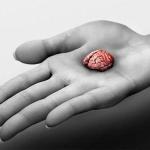
Long before Zika virus made it a household word, the birth defect called microcephaly puzzled scientists and doctors — even as it changed the lives of the babies born with it during the pre-Zika era. But new discoveries reported by an international team of scientists may help explain what happens in the developing brains of babies still in the womb, causing them to be born with small brains and heads.
From Sci Fi to reality: Unlocking the secret to growing new limbs

Many lower organisms retain the miraculous ability to regenerate form and function of almost any tissue after injury. Humans share many of our genes with these organisms, but our capacity for regeneration is limited. So scientists are studying the genetics of these organisms to find out how regenerative mechanisms might be activated in humans.
FAMIN or feast? Newly discovered mechanism influences how immune cells ‘eat’ invaders

A new mechanism that affects how our immune cells perform – and hence their ability to prevent disease – has been discovered by an international team of researchers. To date, researchers have identified hundreds of genetic variants that increase or decrease the risk of developing diseases from cancer and diabetes to tuberculosis and mental health disorders.
Embryonic gene Nanog reverses aging in adult stem cells

The fountain of youth may reside in an embryonic stem cell gene named Nanog. In a series of experiments, the gene kicked into action dormant cellular processes that are key to preventing weak bones, clogged arteries and other telltale signs of growing old. The findings also show promise in counteracting premature aging disorders such as Hutchinson-Gilford progeria syndrome.
Stem cells feel the force
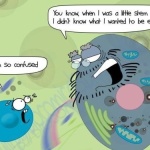
All cells share the same genetic code, no matter if they are skin or brain cells. However, these cells are exposed to very different types of mechanical environments and mechanical stresses. For example, brain tissue is very soft, whereas bone is hard. Researchers know that cells respond to extrinsic forces by changing their structure and their gene expression to be better suited for their particular environments and to be able to execute their specific functions.
Erasing unpleasant memories with a genetic switch

Researchers have managed to erase unpleasant memories in mice using a ‘genetic switch’. Dementia, accidents, or traumatic events can make us lose the memories formed before the injury or the onset of the disease. Researchers have now shown that some memories can also be erased when one particular gene is switched off.
Alzheimer’s genetics point to new research direction

A analysis of genetic mutations which cause early-onset Alzheimer’s disease suggests a new focus for research into the causes of the disease. Previous research has revolved around the idea that accumulation in the brain of a small, sticky protein fragment — amyloid beta — causes Alzheimer’s disease.
Genetic repeats suggest role for DNA instability in schizophrenia

My friend has a glass eye and unless you knew the story you might not think anything of it. His older brother did it. You read that correctly, in a schizophrenic induced confusion he tried to killed him. He never held what happened against his older brother, he was sick, how could he? The courts say, he cannot visit his brother while he’s in prison. This could’ve been avoided with early detection and now international researchers have used a new technique to identify significantly more DNA sequence repeats in patients with schizophrenia than in control individuals.
Fear factor: A new genetic candidate for treating PTSD


Image credit goes to the very talented: Lora Zombie
Researchers have identified a new genetic candidate for testing therapies that might affect fear learning in people with PTSD or other conditions. Individuals with trauma- and stress-related disorders can manifest symptoms of these conditions in a variety of ways. Genetic risk factors for these and other psychiatric disorders have been established but do not explain the diversity of symptoms seen in the clinic – why are some individuals affected more severely than others and why do some respond better than others to the same treatment?
The truth is out there: Scientists unlock X-Files DNA mystery


Scientists have unlocked a crucial part of the mystery as to how our DNA can replicate and repair itself – something which is essential for all life forms. The new research has revealed how branched DNA molecules are removed from the iconic double-helical structure -a process which scientists have been looking to unlock for over 20 years.
Epigenetic study of lactose intolerance may shed light on the origin of mental illness

A new study on the epigenetics of lactose intolerance may provide an approach to understanding schizophrenia and other complex, serious illnesses. While that may seem odd, both lactose intolerance and schizophrenia are inherited. In addition, neither condition emerges in the first years of life, but rather both appear years or even decades later.
Bad news, fructose alters hundreds of brain genes

Got a sweet tooth? Maybe you even have some sugary goodness with you right now… as you are reading this. Well you may want to put that down.We know a range of diseases — from diabetes to cardiovascular disease, and from Alzheimer’s disease to attention deficit hyperactivity disorder — are linked to changes to genes in the brain. Unfortunately for those who love their pop tarts, a new study has found that hundreds of those genes can be damaged by fructose, a sugar that’s common in the Western diet, in a way that could lead to those diseases.
Celiac disease: ‘Junk’ DNA not quite junk

Despite the fad to go ‘gluten free,’ the only people who actually suffer from consumption of gluten are those with coeliac disease — so if you don’t have the disease and like to limit yourself to gluten-free foods, you are missing out, and no gluten intolerance is not a real thing. The problem comes from the immune system and is manifested as intolerance to gluten — tasty proteins present in wheat, rye, and barley that help give baked goods their fluff. The intolerance leads to an inflammatory reaction in the small intestine that hampers the absorption of nutrients.
Uncovering the genetic elements that drive regeneration

Lose a hand or a leg? It will grow back… oh wait, it won’t, but why not? Trace our evolution — long before the shedding of gills or the development of opposable thumbs — and you will likely find a common ancestor with the amazing ability to regenerate lost body parts. There is theoretically no reason why we shouldn’t be able to regenerate, not quite like in the movie Deadpool, but come on, would you really complain at that point?
Stopping organ rejection: An end to the medication

If you’re a transplant recipient you know that transplant organs are a veritable ticking time bomb waiting to be rejected by your well-meaning (but stupid) body. Not only can you do everything right and still have the organs rejected, you have to take a steady stream of expensive pills to inhibit the immune system and stop the body from launching its attack. Don’t throw your pill organizers away just yet, but soon.
Spoiler alert: Water bears do not have extensive foreign DNA

Tardigrades, they are cute and cuddly — okay maybe not cuddly — but they have earned their nicknames, such as moss piglets or water bears. Mostly because they look like, well bears (although I don’t see a piglet personally). These guys are eight-legged microscopic animals that have long fascinated scientists for their ability to survive extremes of temperature, pressure, lack of oxygen, and even radiation exposure. Talk about a thrill seeker they can even survive in space, without a suit, where were humans when they were handing out those genes?
Ancient viruses lurk in our DNA

Think your DNA is all human? Think again. And a new discovery suggests it’s even less human than scientists previously thought. Nineteen new pieces of non-human DNA — left by viruses that first infected our ancestors hundreds of thousands of years ago — have just been found, lurking between our own genes.
Using precision medicine to define the genetics of autoimmune disease

Demonstrating the potential of precision medicine, an international study used next-generation DNA sequencing technology to identify more than 1,000 gene variants that affect susceptibility to systemic lupus erythematosus (SLE). Precision medicine is an emerging field that aims to deliver highly personalized health care by understanding how individual differences in genetics, environment, and lifestyle impact health and disease.
Antibiotic resistance, evolution, and our future

Without the discovery of antibiotics we could not — and most certainly would not — be living in the world we do today. It was a discovery that would save countless lives, while simultaneously compromising our future. From the use (and unfortunate misuse) of antibiotics, we gave rise to more virulent bacteria that have become resistant to more and more types of antibiotics.
Some bacterial CRISPRs can snip RNA, too

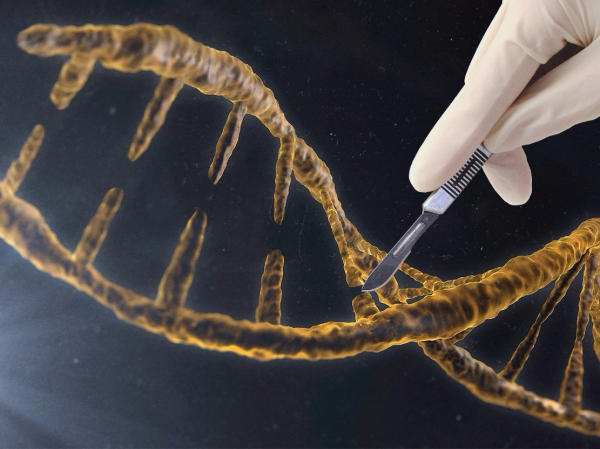
You’ve probably seen news stories about the highly lauded, much-discussed genome editing system CRISPR/Cas9. But did you know the system was actually derived from bacteria, which use it to fight off foreign invaders such as viruses? It allows many bacteria to snip and store segments of DNA from an invading virus, which they can then use to “remember” and destroy DNA from similar invaders if they are encountered again. Recent work from a team of researchers including Carnegie’s Devaki Bhaya demonstrates that some bacteria also use the CRISPR/Cas system to snip and recognize segments of RNA, not just DNA.
Scientists discover the way to a new generation of antibiotics
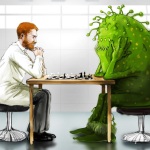
Antibiotic resistance is becoming a common occurrence. Once isolated, more and more we are turning away from the traditional antibiotics to our so called “last line of defense” antibiotics to fight infections. Sadly, in a growing number of cases these antibiotics are having less of an effect. However, new research reveals the mechanism by which drug-resistant bacterial cells maintain a defensive barrier.
A way to track and stop human and agricultural viruses

Viruses are molecular thieves that take from their hosts under the cloak of darkness. But now a Virginia Tech scientist has found a way to not only track viral hijackers, but also potentially stop them from replicating. The discovery has broad ranging applications in stopping viral outbreaks such as Hepatitis C in humans and a number of viruses in plants and animals because it applies to many viruses in the largest category of viral classes — positive-strand RNA viruses.
‘Jaws’ may help humans grow new teeth, shark study suggests

A new insight into how sharks regenerate their teeth, which may pave the way for the development of therapies to help humans with tooth loss, has been discovered by scientists. The study has identified a network of genes that enables sharks to develop and regenerate their teeth throughout their lifetime. The genes also allow sharks to replace rows of their teeth using a conveyer belt-like system.
Stem cell gene therapy could be key to treating Duchenne muscular dystrophy

Scientists at the UCLA Eli and Edythe Broad Center of Regenerative Medicine and Stem Cell Research and Center for Duchenne Muscular Dystrophy at UCLA have developed a new approach that could eventually be used to treat Duchenne muscular dystrophy. The stem cell gene therapy could be applicable for 60 percent of people with Duchenne, which affects approximately 1 in 5,000 boys in the U.S. and is the most common fatal childhood genetic disease.
We can build it better: Synthetic biopathway turns agriculture waste into ‘green’ products

Researchers at the University of Minnesota have engineered a new synthetic biopathway that can more efficiently and cost-effectively turn agricultural waste, like corn stover and orange peels, into a variety of useful products ranging from spandex to chicken feed.
The molecular link between psychiatric disorders and type 2 diabetes

There may be a genetic connection between some mental health disorders and type 2 diabetes. In a new report, scientists show that a gene called “DISC1,” which is believed to play a role in mental health disorders, such as schizophrenia, bipolar disorder and some forms of depression, influences the function of pancreatic beta cells which produce insulin to maintain normal blood glucose levels.
How to unlock inaccessible genes
An international team of biologists has discovered how specialized enzymes remodel the extremely condensed genetic material in the nucleus of cells in order to control which genes can be used. It was known that the DNA in cells is wrapped around proteins in structures called nucleosomes that resemble beads on a string, which allow the genetic material to be folded and compacted into a structure called chromatin.
Scientists shed new light on workings of genetic regulation
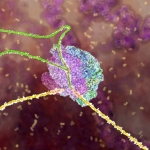
A team of scientists has uncovered greater intricacy in protein signaling than was previously understood, shedding new light on the nature of genetic production.
Thwarting abnormal neural development with a new mutation

Researchers at the RIKEN Brain Science Institute in Japan have discovered how to reverse the abnormal axonal development characteristic of CFEOM3, a congenital disease that affects the muscles that control eye movements. The work shows how creating a specific mutation rescued abnormal axonal growth in the developing mouse brain.
Autism-linked protein lays groundwork for healthy brain

A gene linked to mental disorders helps lays the foundation for a crucial brain structure during prenatal development, according to Salk Institute research. The findings reveal new mechanistic insights into the gene, known as MDGA1, which may bring a better understanding of neurodevelopmental disorders in people.
Are you multicellular? Thank a random mutation that created a new protein

All it took was one mutation more than 600 million years ago. With that random act, a new protein function was born that helped our single-celled ancestor transition into an organized multicellular organism. That’s the scenario — done with some molecular time travel — that emerged from basic research in the lab of University of Oregon biochemist Ken Prehoda.
Schizophrenia linked to loss of cells in the brain’s memory center


Art by the one and only Lora Zombie
Scientists at Columbia University’s Mortimer B. Zuckerman Mind Brain Behavior Institute, Columbia University Medical Center (CUMC), and the Université Paris Descartes have found that deficits in social memory–a crucial yet poorly understood feature of psychiatric disorders such as schizophrenia–may be due to a decrease in the number of a particular class of brain cells, called inhibitory neurons, in a little-explored region within the brain’s memory center.
New genes born by accident lead to evolutionary innovation

Novel genes are continuously emerging during evolution, but what drives this process? A new study has found that the fortuitous appearance of certain combinations of elements in the genome can lead to the generation of new genes.
Gene-editing technique stops progression of Duchenne muscular dystrophy

Using a new gene-editing technique, a team of scientists from UT Southwestern Medical Center stopped progression of Duchenne muscular dystrophy (DMD) in young mice. If efficiently and safely scaled up in DMD patients, this technique could lead to one of the first successful genome editing-based treatments for this fatal disease, researchers said.
The development of the cerebellar circuitry is driven by epigenetic “music”

From before birth through childhood, connections form between neurons in the brain, ultimately making us who we are. So far, scientists have gained a relatively good understanding of how neural circuits become established, but they know less about the genetic control at play during this crucial developmental process. Now, a team of researchers has described for the first time the so-called epigenetic mechanisms underlying the development of the cerebellum, the portion of the brain that allows us to learn and execute complex movements.
Lack of serotonin alters development and function in the brain

Researchers at Case Western Reserve University School of Medicine have created the first complete model to describe the role that serotonin plays in brain development and structure. Serotonin, also called 5-hydroxytryptamine [5-HT], is an important neuromodulator of brain development and the structure and function of neuronal (nerve cell) circuits.
Intelligence, it’s in your genes… and we can change that.

Ever feel like everyone around you has their brain running much faster than your own? Well, the good news is that it may not be you, it may be your genes. The other good news, we might be able to change that. Scientists from Imperial College London have identified for the first time two clusters of genes linked to human intelligence. Called M1 and M3, these so-called gene networks appear to influence cognitive function – which includes memory, attention, processing speed and reasoning.
Discovery puts designer dopamine neurons within reach

For decades, the elusive holy grail in Parkinson’s disease research has been finding a way to repair faulty dopamine neurons and put them back into patients, where they will start producing dopamine again. Researchers have used fetal material, which is difficult to obtain and of variable quality. Embryonic stem cells represented a tremendous innovation, but making dopamine neurons from stem cells is a long process with a low yield.
Healthy or sick? Tiny cell bubbles may hold the answer

Rutgers scientists have uncovered biological pathways in the roundworm that provide insight into how tiny bubbles released by cells can have beneficial health effects, like promoting tissue repair, or may play a diabolical role and carry disease signals for cancer or neurodegenerative diseases like Alzheimer’s.
Seeing viruses in a new light

Want to make a virus? It’s easy: combine one molecule of genomic nucleic acid, either DNA or RNA, and a handful of proteins, shake, and in a fraction of a second you’ll have a fully-formed virus. While that may sound like the worst infomercial ever, in many cases making a virus really is that simple. Viruses such as influenza spread so effectively, and as a result can be so deadly to their hosts, because of their ability to spontaneously self-assemble in large numbers.
Novel insights into genetic cause of autoimmune diseases
A collaboration between researchers at the Babraham Institute and the University of Manchester has mapped the physical connections occurring in the genome to shed light on the parts of the genome involved in autoimmune diseases. Using a new technique, called Capture Hi-C, the team revealed novel insights into how changes in the genetic sequence have a biological effect and increase the risk of disease.
The silence of the genes, an epigenetic tale
Research led by Dr. Keiji Tanimoto from the University of Tsukuba, Japan, has brought us closer to understanding the mechanisms underlying the phenomenon of genomic imprinting. In this intriguing event, one copy of a gene is ‘turned off’, or silenced, depending on whether it was derived from the mother or the father.
The rise of do-it-yourself biology
The Wilson Center’s Synthetic Biology Project has released a short documentary on the growth of the do-it-yourself biology (DIYbio) movement as seen through a community DIYbio lab in Baltimore, Maryland.
















































